An Experimental Investigation of Hardwoods Harvested in Croatian Forests for the Production of Glued Laminated Timber
Abstract
1. Introduction
2. Materials and Methods
2.1. Production of Glulam Beams
2.2. Relative Bond Shear Strength Tests
2.3. Bending Test Setup
3. Results and Discussion
3.1. Relative Bond Shear Strength Tests
3.2. Bending Tests
4. Conclusions
- -
- The relative bond shear strength test for melamine–urea adhesive and glulam from Turkey oak showed satisfactory results regardless of the surface treatment of the lamellas;
- -
- The relative bond shear strength tests for melamine–urea adhesive and glulam from European hornbeam showed satisfactory results in planed and fine-sanded lamellas (grit 80) and unsatisfactory results in rough-sanded lamellas (grit 60);
- -
- The relative bond shear strength tests for melamine–urea adhesive and glulam from maple showed unsatisfactory results regardless of the surface treatment of the lamellas.
- -
- The bending tests of the glulam showed higher bending strength for the glulam made from European hornbeam compared to the glulam from Turkey oak and maple;
- -
- The glulam from European hornbeam and maple showed no significant differences in the bending strength for the different surface treatments of the lamellas.
- -
- The glulam from Turkey oak with rough sanding of the lamellas (grit 60) showed significantly higher bending strength and stiffness compared to the glulam with planed or fine-sanded lamellas (grit 80).
Author Contributions
Funding
Conflicts of Interest
References
- Abrahamsen, R. Mjøstårnet-Construction of an 81 m tall timber building. In Proceedings of the Internationales Holzbau-Forum IHF 2017, Garmisch-Partenkirchen, Germany, 6–8 December 2017. [Google Scholar]
- Östman, B.; Brandon, D.; Frantzich, H. Fire safety engineering in timber buildings. Fire Saf. J. 2017, 91, 11–20. [Google Scholar] [CrossRef]
- Stepinac, M.; Šušteršič, I.; Gavrić, I.; Rajčić, V. Seismic design of timber buildings: Highlighted challenges and future trends. Appl. Sci. 2020, 10, 1380. [Google Scholar] [CrossRef]
- Hough, R. Rethinking Timber Buildings Seven Perspectives on the Use of Timber in Building Design and Construction; ARUP: London, UK, 2019. [Google Scholar]
- Smith, I.; Snow, M.A. Timber: An ancient construction material with a bright future. For. Chron. 2008, 84, 504–510. [Google Scholar] [CrossRef]
- Hart, J.; Pomponi, F. More timber in construction: Unanswered questions and future challenges. Sustainability 2020, 12, 3473. [Google Scholar] [CrossRef]
- EN 14080; Timber Structures—Glued Laminated Timber and Glued Solid Timber—Requirements. European Committee for Standardization: Brussels, Belgium, 2013.
- Linder, M.; Garcia-Gonzalo, J.; Kolstrom, M.; Green, T.; Reguera, R.; Maroschek, M.; Seidl, R.; Lexer, M.; Netherer, S.; Schopf, A.; et al. Impacts of climate change on European forests and options for adaptation. In Report to the European Commission Directorate-General for Agriculture and Rural Development; European Forest Institute with BOKU/INRA/IAFS; European Forest Institute: Joensuu, Finland, 2008. [Google Scholar]
- Forest Europe. State of Europe’s Forests 2020. In Proceedings of the Ministerial Conference on the Protection of Forests in Europe—Forest Europe, Bratislava, Slovak Republic, 14–15 April 2021. [Google Scholar]
- Krackler, V.; Keunecke, D.; Niemz, P.; Hurst, A. Possible fields of hardwood application. Wood Res. 2011, 56, 125–136. [Google Scholar]
- Van Acker, J. Opportunities and challenges for hardwood based engineered wood products. In Proceedings of the 9th Hardwood Proceedings Part II, Sopron, Hungary, 24–25 June 2021. [Google Scholar]
- Wehrmann, W.; Torno, S. Laubholz für Tragende Konstruktionen; Cluster-Initiative Forst und Holz in Bayern gGmbH: Freising, Germany, 2015. [Google Scholar]
- Frese, M.; Blaß, H.J. Beech glulam strength classes. In Proceedings of the International Council for Research and Innovation in Building and Construction, Working Commission W18—Timber Structures, Meeting Thirty-Eight, Universität Karlsruhe, Karlsruhe, Germany, 29–31 August 2005. [Google Scholar]
- Ehrhart, T.; Fink, G.; Steiger, R.; Frangi, A. Strength grading of European beech lamellas for the production of GLT & CLT. In Proceedings of the International Network on Timber Engineering Research, Graz, Austria, 16–19 August 2016. [Google Scholar]
- Van de Kuilen, J.W.; Torno, S. Materialkennwerte von Eschenholz für den Einsatz in Brettschichtholz; Bundesministerium für Wirtschaft und Energie, Schlussbericht zum Vorhaben: Munchen, Germany, 2014. [Google Scholar]
- Knorz, M.; Schmidt, M.; Torno, S.; van de Kuilen, J.W. Structural bonding of ash (Fraxinus excelsior L.): Resistance to delamination and performance in shearing tests. Eur. J. Wood Wood Prod. 2014, 72, 297–309. [Google Scholar] [CrossRef]
- Aicher, S.; Ohnesorge, D. Shear strength of glued laminated timber made from European beech timber. Eur. J. Wood Wood Prod. 2011, 69, 143–154. [Google Scholar] [CrossRef]
- Aicher, S.; Ruckteschell, N. Brettschichtholz aus Eiche. In Proceedings of the 2. Stuttgarter Hozbau-Symposium, Stuttgart, Germany, 8–9 November 2012. [Google Scholar]
- Aicher, S.; Christian, Z.; Dill-Langer, G. Hardwood Glulams—Emerging Timber Products of Superior Mechanical Properties. In Proceedings of the World Conference on Timber Engineering, Quebec City, QC, Canada, 10–14 August 2014. [Google Scholar]
- Uzelac Glavinić, I.; Boko, I.; Torić, N.; Lovrić Vranković, J. Application of hardwood for glued laminated timber in Europe. Gradevinar 2020, 72, 607–616. [Google Scholar] [CrossRef]
- EAD 130320-00-0304; Glued Laminated Timber Made of Solid Hardwood. European Organisation for Technical Assessment (EOTA): Bruxelles, Belgium, 2018.
- Aicher, S.; Ahmad, Z.; Hirsch, M. Bondline shear strength and wood failure of European and tropical hardwood glulams. Eur. J. Wood Wood Prod. 2018, 76, 1205–1222. [Google Scholar] [CrossRef]
- Hrvatske šume, d.o.o. Godišnje izvješće 2020. In Proceedings of the Intergrafika TTŽŠumskogospodarsko Područje Republike Hrvatske, Šumskogospodarska osnova, Uređajni Zapisnik, Zaprešić Zagreb, Croatia, 2021. [Google Scholar]
- Caudullo, G.; Welk, E.; San-Miguel-Ayanz, J. Chorological maps for the main European woody species. Data Brief 2017, 12, 662–666. [Google Scholar] [CrossRef] [PubMed]
- Knorz, M.; Neuhaeuser, E.; Torno, S.; van de Kuilen, J.W. Influence of surface preparation methods on moisture-related performance of structural hardwood–adhesive bonds. Int. J. Adhes. Adhes. 2015, 57, 40–48. [Google Scholar] [CrossRef]
- Jiang, J.; Du, J.; Li, H.; Mei, C.; Gong, X. Hydrophobicity Improvement on Wood for a Better Application of This Bio-Based Material. Coatings 2022, 12, 1465. [Google Scholar] [CrossRef]
- Technical Data Sheet for Prefere 4535; Prefere by dynea; Dynea: Lillestrøm, Norway, 2019.
- EN 408; Timber Structures—Structural Timber and Glued Laminated Timber—Determination of Some Physical and Mechanical Properties. European Committee for Standardization: Brussels, Belgium, 2012.
- EN 14358; Timber Structures—Calculation and Verification of Characteristic Values. European Committee for Standardization: Brussels, Belgium, 2016.
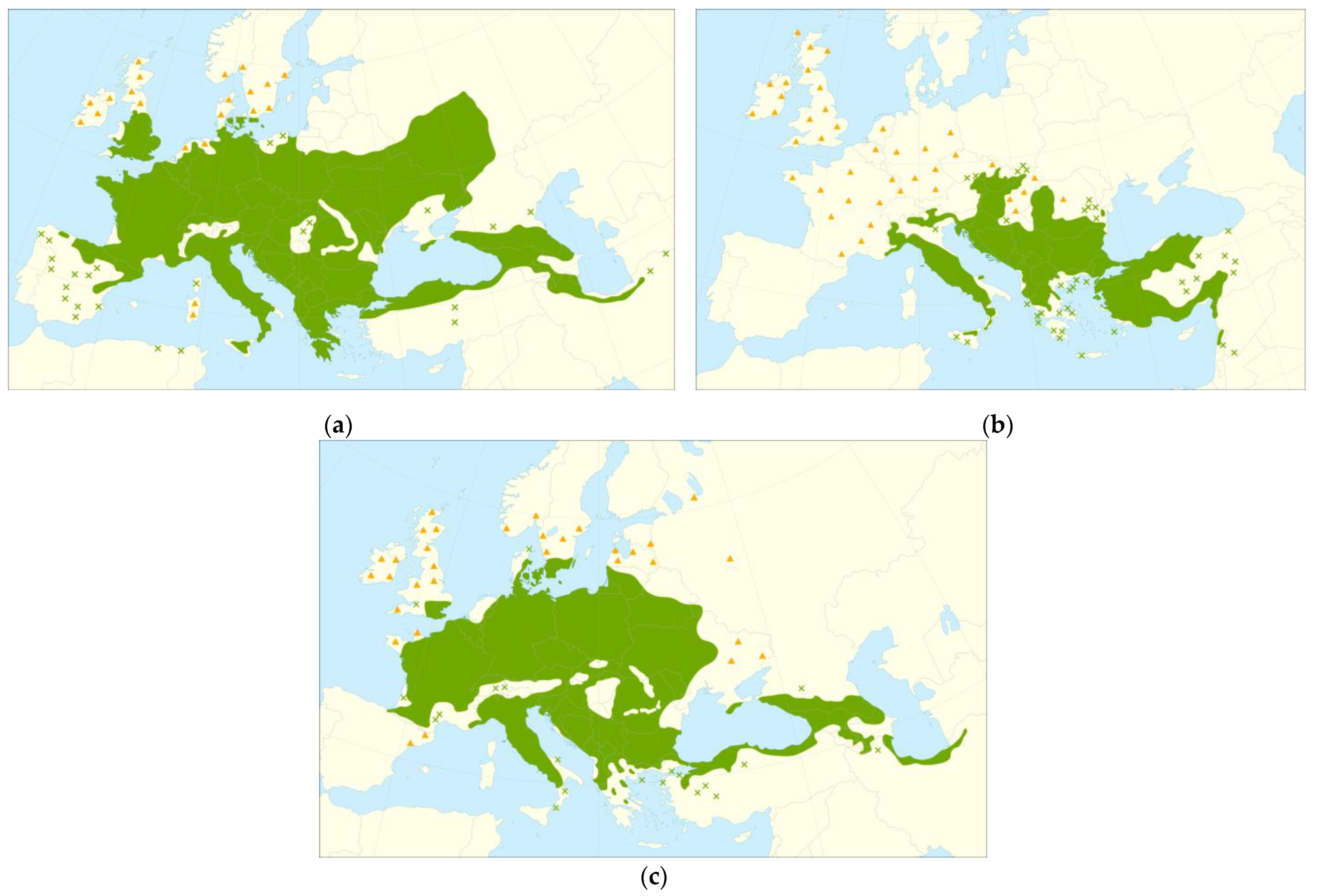

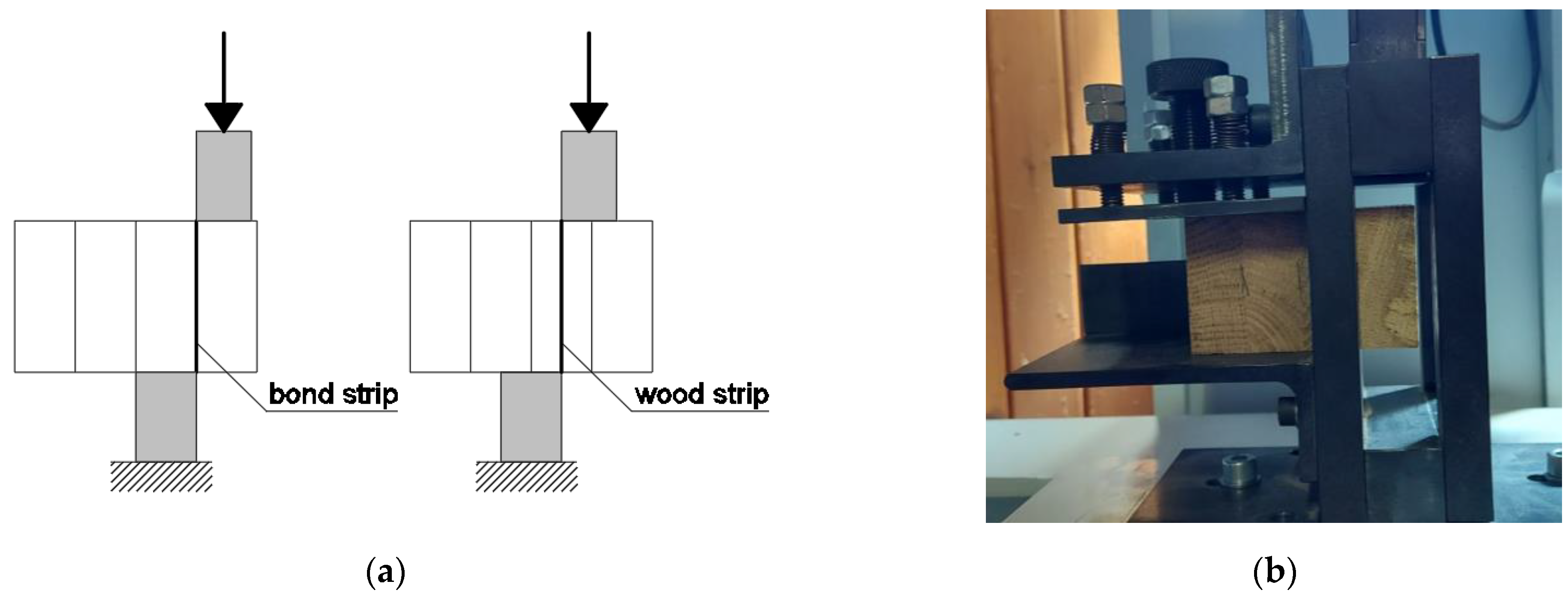

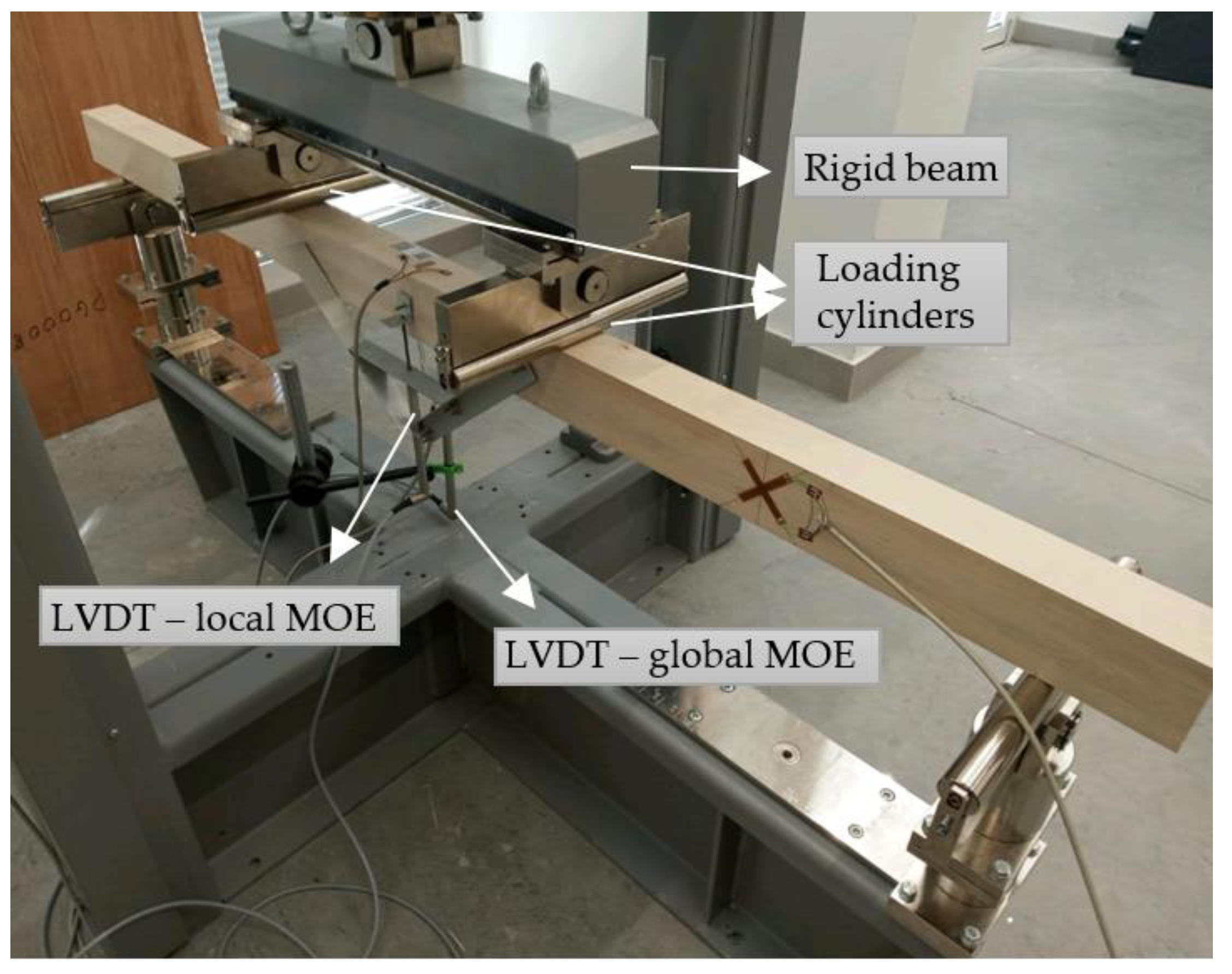

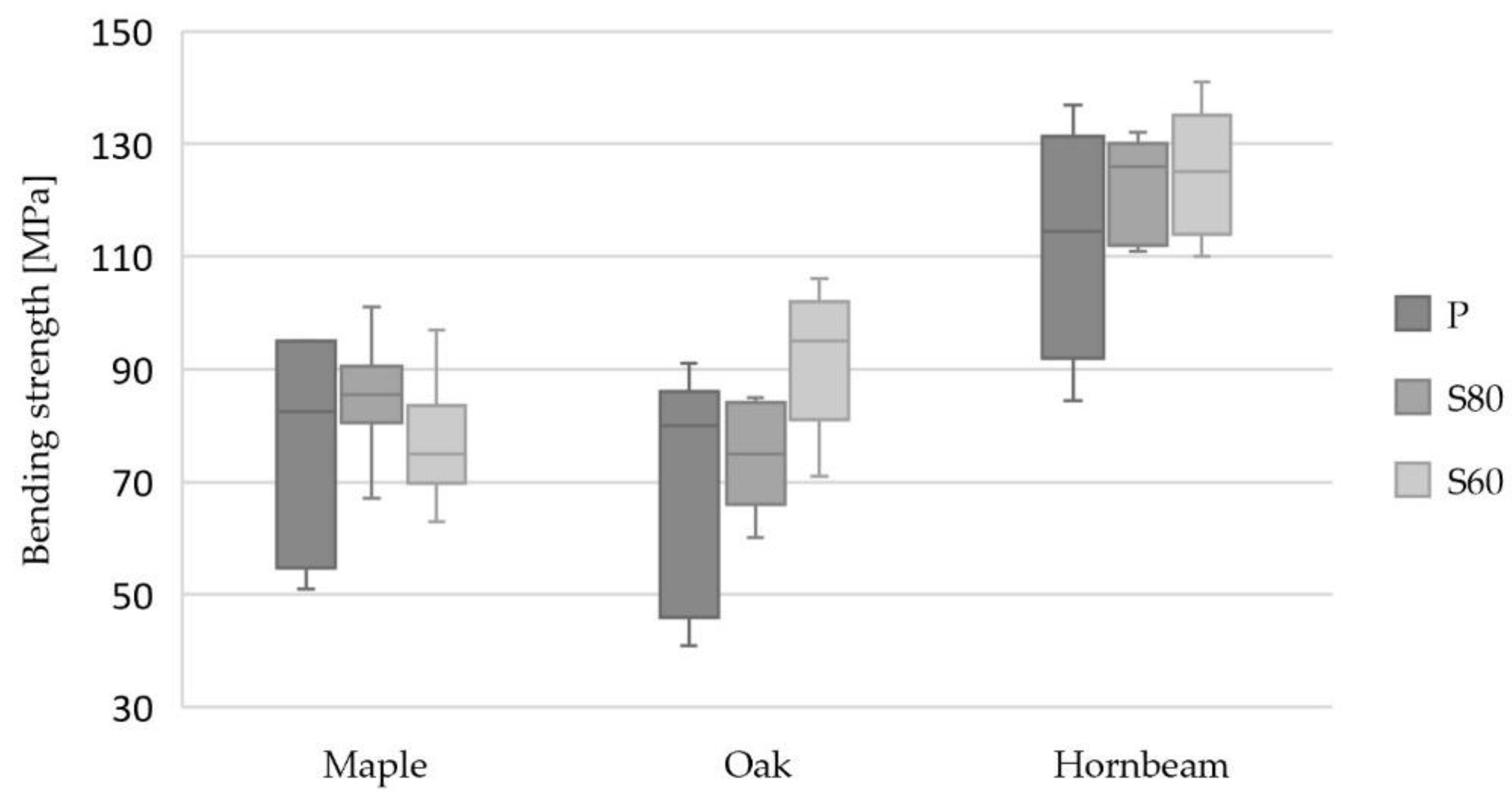
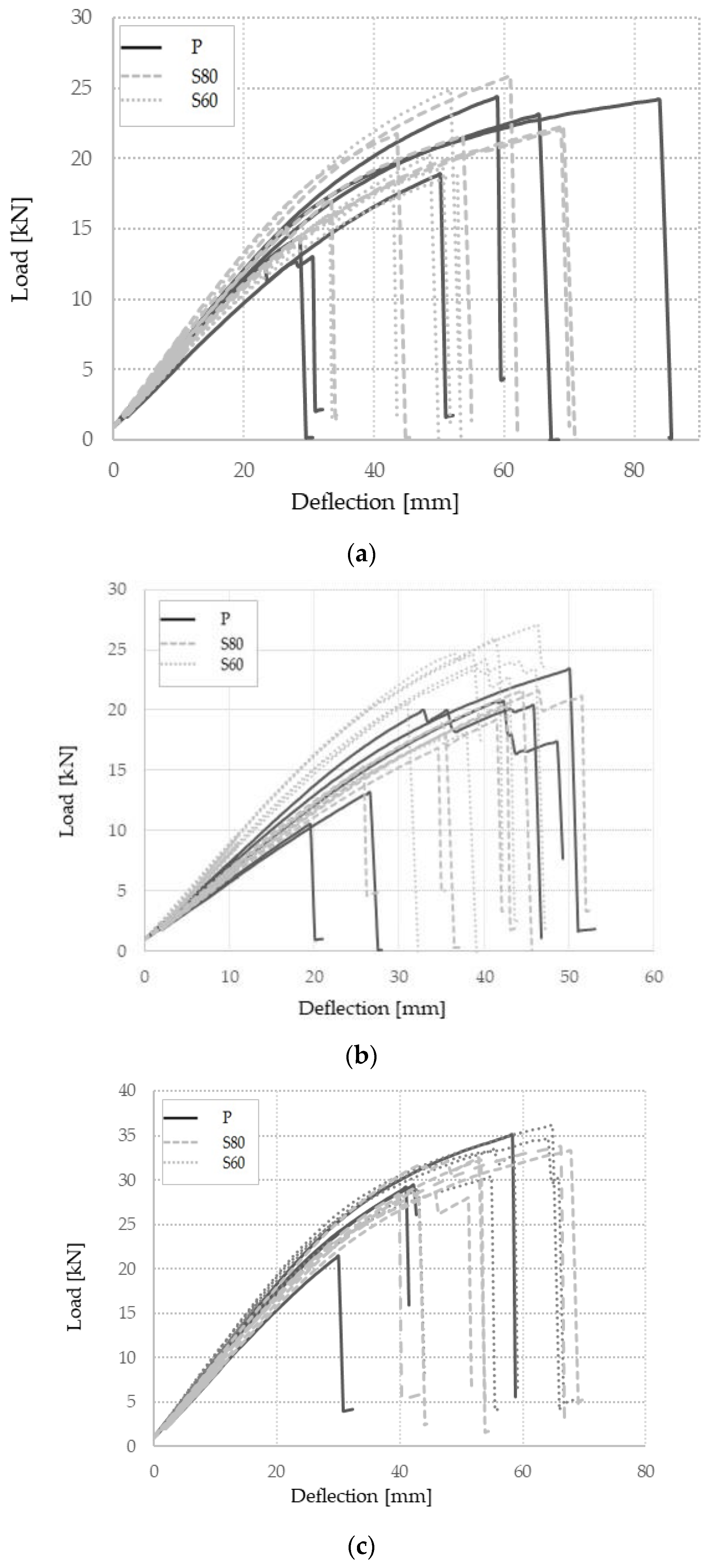
| Maple | Turkey Oak | Hornbeam | |||||||
|---|---|---|---|---|---|---|---|---|---|
| P | S80 | S60 | P | S80 | S60 | P | S80 | S60 | |
| n | 9 | 9 | 9 | 6 | 6 | 6 | 6 | 6 | 6 |
| 19.60 | 18.67 | 18.31 | 16.32 | 16.91 | 16.49 | 21.63 | 22.67 | 19.16 | |
| [] | 21.89 | 21.89 | 21.89 | 14.07 | 14.07 | 14.07 | 22.98 | 22.98 | 22.98 |
| [%] | 81 | 59 | 59 | 100 | 95 | 91 | 95 | 100 | 73 |
| 0.90 | 0.85 | 0.84 | 1.16 | 1.20 | 1.17 | 0.94 | 0.99 | 0.83 | |
| [] | 16.15 | 14.40 | 12.99 | 12.55 | 12.18 | 12.91 | 14.55 | 17.99 | 16.35 |
| [] | 18.70 | 18.70 | 18.70 | 8.61 | 8.61 | 8.61 | 12.12 | 12.12 | 12.12 |
| [%] | 15 | 5 | 5 | 100 | 80 | 80 | 90 | 100 | 20 |
| 0.86 | 0.77 | 0.69 | 1.46 | 1.42 | 1.50 | 1.20 | 1.48 | 1.35 | |
| Maple | Turkey Oak | Hornbeam | |||||||
|---|---|---|---|---|---|---|---|---|---|
| P | S80 | S60 | P | S80 | S60 | P | S80 | S60 | |
| n | 6 | 6 | 6 | 5 | 7 | 7 | 4 | 7 | 7 |
| 77 | 85.2 | 76.8 | 68.8 | 74.1 | 92.3 | 112.6 | 121.4 | 125 | |
| [] | 21.9 | 11.3 | 10.9 | 24.8 | 9.6 | 13.1 | 22.8 | 9.4 | 11.4 |
| 11,350 | 11,924 | 11,121 | 11,836 | 11,797 | 15,928 | 17,580 | 17,173 | 18,281 | |
| [] | 1066.8 | 906.2 | 1029.1 | 1677.3 | 607.5 | 1852.1 | 1343.6 | 859.7 | 1769.3 |
| 11,547 | 11,628 | 11,313 | 11,803 | 12,259 | 16,868 | 18,686 | 18,152 | 19,072 | |
| [] | 1078 | 1257.2 | 1433.8 | 1445.1 | 970 | 2116.3 | 936.9 | 1853.5 | 1830.6 |
| Source of Variation | SS | df | MS | F | p-Value | |
|---|---|---|---|---|---|---|
| Between groups | 1917.5 | 2 | 958.7 | 4.6 | 0.025 | 3.633 |
| Within groups | 3275.1 | 16 | 204.7 | |||
| Total | 5192.6 | 18 |
| Contrast | Difference | Standardized Difference | Critical Value | Pr > Diff | Significant |
|---|---|---|---|---|---|
| S60 1 vs. P 2 | 23.486 | 2.803 | 3.144 | 0.032 | Yes |
| S60 vs. S80 3 | 18.143 | 2.372 | 2.998 | 0.031 | Yes |
| S80 vs. P | 5.343 | 0.638 | 2.998 | 0.533 | No |
Disclaimer/Publisher’s Note: The statements, opinions and data contained in all publications are solely those of the individual author(s) and contributor(s) and not of MDPI and/or the editor(s). MDPI and/or the editor(s) disclaim responsibility for any injury to people or property resulting from any ideas, methods, instructions or products referred to in the content. |
© 2023 by the authors. Licensee MDPI, Basel, Switzerland. This article is an open access article distributed under the terms and conditions of the Creative Commons Attribution (CC BY) license (https://creativecommons.org/licenses/by/4.0/).
Share and Cite
Uzelac Glavinić, I.; Boko, I.; Lovrić Vranković, J.; Torić, N.; Abramović, M. An Experimental Investigation of Hardwoods Harvested in Croatian Forests for the Production of Glued Laminated Timber. Materials 2023, 16, 1843. https://doi.org/10.3390/ma16051843
Uzelac Glavinić I, Boko I, Lovrić Vranković J, Torić N, Abramović M. An Experimental Investigation of Hardwoods Harvested in Croatian Forests for the Production of Glued Laminated Timber. Materials. 2023; 16(5):1843. https://doi.org/10.3390/ma16051843
Chicago/Turabian StyleUzelac Glavinić, Ivana, Ivica Boko, Jelena Lovrić Vranković, Neno Torić, and Mario Abramović. 2023. "An Experimental Investigation of Hardwoods Harvested in Croatian Forests for the Production of Glued Laminated Timber" Materials 16, no. 5: 1843. https://doi.org/10.3390/ma16051843
APA StyleUzelac Glavinić, I., Boko, I., Lovrić Vranković, J., Torić, N., & Abramović, M. (2023). An Experimental Investigation of Hardwoods Harvested in Croatian Forests for the Production of Glued Laminated Timber. Materials, 16(5), 1843. https://doi.org/10.3390/ma16051843








